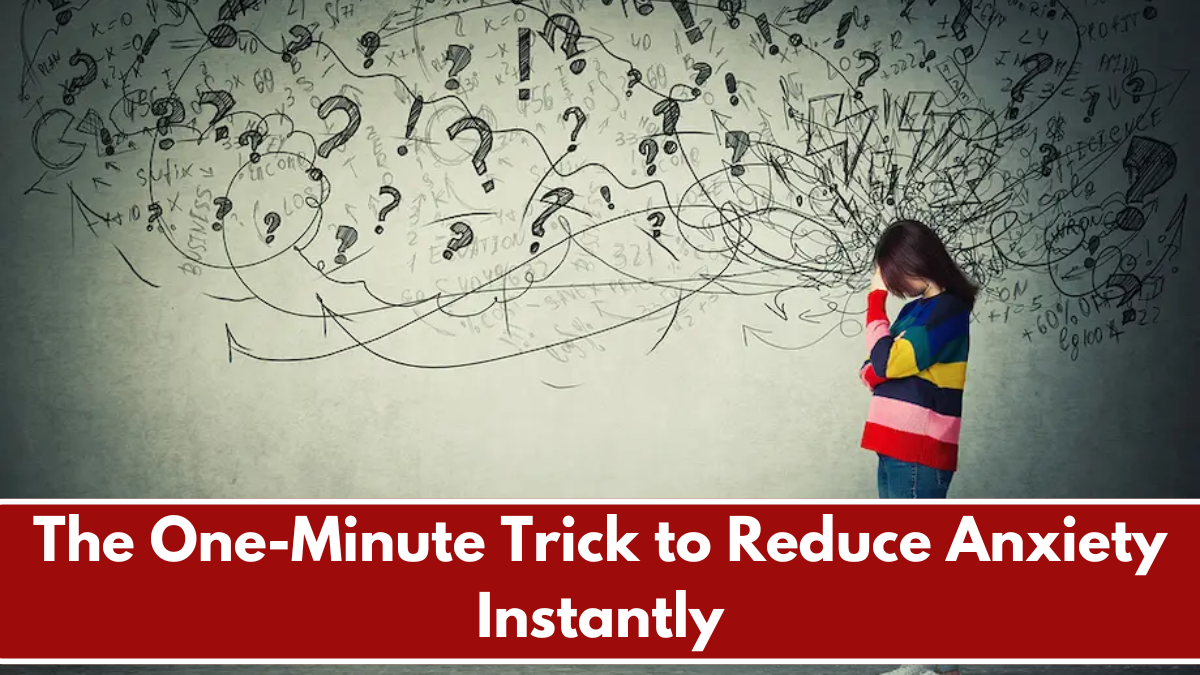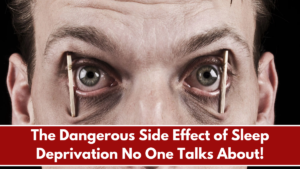Anxiety is a silent epidemic affecting millions of people worldwide. Whether it’s due to work stress, relationship struggles, financial worries, or simply the fast-paced nature of modern life, anxiety can take a serious toll on your mental and physical well-being.
While long-term strategies like meditation, therapy, and lifestyle changes are important for managing anxiety, what do you do when anxiety strikes in the moment? What if you’re about to step into an important meeting, give a speech, or face a stressful situation, and you feel your heart pounding, your palms sweating, and your mind racing?
The good news is that there’s a simple one-minute trick that can reduce anxiety instantly. It’s backed by science, requires no special tools, and can be done anywhere, anytime.
In this article, we’ll explore:
- What this one-minute trick is and how it works
- The science behind why it’s so effective
- Other quick strategies to calm anxiety on the spot
- Long-term solutions to keep anxiety under control
By the end, you’ll have a powerful tool to stop anxiety in its tracks whenever it appears.
The One-Minute Trick to Reduce Anxiety Instantly
What Is the One-Minute Trick?
The secret to instant anxiety relief is a simple yet powerful technique called the 4-7-8 breathing method. Developed by Dr. Andrew Weil, this breathing exercise quickly slows down your nervous system, lowers stress hormones, and brings a sense of calm within seconds.
Here’s how to do it:
- Inhale deeply through your nose for 4 seconds.
- Hold your breath for 7 seconds.
- Exhale slowly through your mouth for 8 seconds.
- Repeat this cycle for one minute (about 4-5 breaths).
That’s it! In just one minute, your body will begin to relax, your heart rate will slow, and your mind will clear.
Why Does This Trick Work?
This technique works because breathing directly influences the nervous system. When you’re anxious, your body goes into fight-or-flight mode, causing rapid breathing, increased heart rate, and a rush of stress hormones like cortisol.
The 4-7-8 breathing method helps in three key ways:
- Slows the heart rate: The extended exhale activates the parasympathetic nervous system, which signals the body to calm down.
- Stops shallow breathing: Anxiety causes quick, shallow breaths, which can make symptoms worse. This technique forces you to breathe deeply and bring in more oxygen.
- Lowers stress hormones: Controlled breathing reduces the levels of cortisol and adrenaline, making you feel more relaxed and in control.
Studies have shown that deep breathing exercises can reduce anxiety, lower blood pressure, and improve overall mental well-being in just a few minutes.
Additional Quick Fixes for Anxiety Relief
While the 4-7-8 breathing method is one of the best instant anxiety reducers, here are some other techniques you can use if you need extra relief:
1. The “5-4-3-2-1” Grounding Technique
This method helps you focus on the present moment and get out of your anxious thoughts:
- 5 things you can see (a tree, a book, your hands, etc.)
- 4 things you can touch (your clothes, a chair, your phone, etc.)
- 3 things you can hear (birds chirping, people talking, a clock ticking, etc.)
- 2 things you can smell (coffee, fresh air, perfume, etc.)
- 1 thing you can taste (mint gum, water, your last meal, etc.)
This method redirects your attention away from anxious thoughts and brings you back to the present moment.
2. The Cold Water Trick
Splashing cold water on your face or holding an ice pack to your neck can trigger the “dive reflex,” which slows your heart rate and calms your nervous system almost instantly.
3. Tense and Release Exercise
Tightly clench your fists or tense your whole body for 5-10 seconds, then release. This helps relax muscle tension caused by anxiety and signals to your brain that it’s okay to calm down.
4. Power Posing
Standing in a strong, confident posture (hands on hips, chest out) for just one minute can reduce cortisol levels and increase feelings of control and calmness.
Long-Term Solutions for Anxiety Management
While instant tricks are great for managing anxiety in the moment, it’s also important to develop long-term habits to keep anxiety under control.
1. Regular Exercise
Physical activity releases endorphins, reduces cortisol, and improves overall mental health. Even a daily 30-minute walk can make a huge difference.
2. Meditation and Mindfulness
Practicing mindfulness meditation for even 5-10 minutes a day can rewire the brain to handle stress more effectively.
3. Healthy Diet
Avoiding excess sugar, caffeine, and processed foods can help keep anxiety at bay. Foods rich in magnesium (nuts, leafy greens), omega-3s (salmon, flaxseeds), and B vitamins (whole grains, eggs) support brain health and reduce anxiety symptoms.
4. Better Sleep Habits
Lack of sleep can increase stress hormones, making anxiety worse. Aim for 7-9 hours of quality sleep per night and establish a calming bedtime routine.
5. Talking to Someone
Sometimes, anxiety can feel overwhelming. Talking to a trusted friend, therapist, or counselor can help you process your emotions and find effective coping strategies.
Conclusion
Anxiety can strike at any moment, but you don’t have to let it take over your life. The 4-7-8 breathing method is a simple, effective, and scientifically proven technique that can calm your mind and body in just one minute.
By incorporating quick-fix anxiety relief techniques and focusing on long-term lifestyle changes, you can reduce stress, feel more in control, and improve your overall mental well-being.
The next time you feel anxious, take a deep breath, count to four, and remind yourself that relief is just a breath away.
FAQ’s:
1. What is the fastest way to calm anxiety instantly?
One of the fastest ways to calm anxiety instantly is controlled breathing, such as the 4-7-8 breathing technique. This method involves inhaling for four seconds, holding for seven seconds, and exhaling for eight seconds. It helps lower heart rate, reduce cortisol levels, and activate the body’s relaxation response. Other quick methods include splashing cold water on your face, grounding exercises, or progressive muscle relaxation. These techniques help shift your focus away from anxious thoughts and bring immediate relief.
2. How does deep breathing reduce anxiety?
Deep breathing works by activating the parasympathetic nervous system, which signals the body to relax. When you’re anxious, your breathing becomes shallow and rapid, which increases feelings of panic. By slowing your breath and extending your exhales, you trick your brain into thinking you are calm, which then lowers stress hormones and reduces physical symptoms of anxiety. Deep breathing also improves oxygen flow to the brain, helping you think more clearly and regain control.
3. Can anxiety really be reduced in one minute?
Yes! While long-term anxiety management requires lifestyle changes, many quick techniques can instantly lower stress levels. The 4-7-8 breathing method, the 5-4-3-2-1 grounding technique, and cold exposure (like splashing water on your face) have been scientifically proven to bring rapid relief. These methods interrupt the stress response, slow down your heart rate, and shift your focus from anxious thoughts to the present moment.
4. What is the 5-4-3-2-1 grounding technique, and how does it help?
The 5-4-3-2-1 grounding technique is a simple yet powerful way to bring your attention to the present moment and reduce anxiety instantly. Here’s how it works:
- 5 things you can see (look around and name objects in your surroundings)
- 4 things you can touch (feel the texture of your clothes, a table, or a soft object)
- 3 things you can hear (listen for distant sounds like birds, music, or a fan)
- 2 things you can smell (breathe in the scent of coffee, soap, or fresh air)
- 1 thing you can taste (savor a mint, gum, or even just the taste of your saliva)
This method helps shift your focus from internal stress to external reality, grounding you in the present moment and stopping spiraling thoughts.
5. Why does splashing cold water on my face help with anxiety?
Splashing cold water on your face activates the dive reflex, a natural physiological response that slows your heart rate and calms your nervous system. This response is designed to help conserve energy when submerged in cold water. The sudden temperature change also distracts your brain from anxious thoughts and brings immediate awareness to your body. Holding an ice pack to your neck or wrists can have a similar calming effect.
6. Can movement help reduce anxiety quickly?
Yes, physical movement is one of the best instant anxiety relievers. Even simple actions like shaking out your hands, stretching, or walking can help release pent-up tension and lower stress hormones. Exercise, even in small doses, releases endorphins, which are natural mood boosters. If you’re feeling overwhelmed, try jumping jacks, a short walk, or even just stretching your arms and legs to reset your nervous system.
7. Is it possible to stop a panic attack before it fully develops?
Yes! The key to stopping a panic attack is to recognize the early signs and take action immediately. Techniques like deep breathing, grounding exercises, or focusing on a calming mantra can help prevent it from escalating. The 4-7-8 breathing method and 5-4-3-2-1 technique are particularly effective for this. Remind yourself that panic attacks are temporary and not dangerous, and try to focus on slowing down your breath to regain control.
8. How does posture affect anxiety levels?
Your posture can directly influence your mood and anxiety levels. Slouching or hunching forward can make anxiety worse because it restricts breathing and signals the brain that you’re in a defensive or stressed state. In contrast, adopting a “power pose” (standing tall with your shoulders back and chest open) can boost confidence, lower cortisol levels, and promote a sense of control. Even sitting upright and taking deep breaths can improve your mental state instantly.
9. What foods or drinks can help reduce anxiety quickly?
Certain foods and drinks have calming effects on the nervous system, including:
- Chamomile tea – Contains compounds that bind to the same brain receptors as anti-anxiety medications.
- Dark chocolate – Helps lower cortisol and boost mood.
- Bananas and avocados – Rich in magnesium, which helps relax muscles and reduce stress.
- Almonds and walnuts – Provide healthy fats and magnesium for anxiety relief.
- Green tea – Contains L-theanine, an amino acid that promotes relaxation.
On the other hand, avoiding caffeine, alcohol, and processed sugar can prevent anxiety spikes and keep your mood stable.
10. How can I train my brain to be less anxious over time?
While instant anxiety relief techniques are helpful, long-term strategies can rewire your brain to be less reactive to stress. Some effective long-term habits include:
- Daily mindfulness meditation – Even 5-10 minutes a day can train your brain to stay calm under stress.
- Journaling – Writing down worries helps process emotions and reduce anxious thoughts.
- Regular exercise – Physical activity builds resilience against stress and boosts serotonin levels.
- Balanced nutrition – A healthy diet with omega-3s, magnesium, and B vitamins supports brain function and reduces anxiety.
- Cognitive behavioral therapy (CBT) techniques – Learning to identify and reframe negative thought patterns can make anxiety less frequent and intense over time.
By combining short-term relief techniques with long-term strategies, you can gain better control over anxiety and improve your overall well-being.



